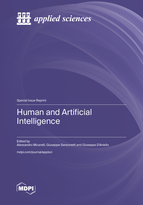Human and Artificial Intelligence
A special issue of Applied Sciences (ISSN 2076-3417). This special issue belongs to the section "Computing and Artificial Intelligence".
Deadline for manuscript submissions: closed (20 August 2022) | Viewed by 32988
Special Issue Editors
Interests: human–computer interaction; adaptive web-based systems; user modeling; personalized search; recommender systems; artificial intelligence in education
Interests: human-computer interaction; user modeling; recommender systems; case-based reasoning; computer vision
Interests: situation awareness; computational intelligence; granular computing; knowledge management
Special Issue Information
Dear Colleagues,
In recent years, significant advances have been made toward the realization of General Artificial Intelligence, especially in the Machine Learning (ML) (e.g., Deep Learning) domain. Several real-world tasks, however, cannot yet be solved by machines alone. Systems are hence needed that rely on the integration of Human and Artificial Intelligence to solve the most complex problems. In many academic and industrial intelligent agents, communication between humans and computers is a key factor. Many challenges, however, can hinder successful cooperation between the two actors. ML algorithms, for instance, fail to provide explanations for their actions, while human cognitive overload and human out-of-the-loop syndrome may result in lower performance.
The goal of this Special Issue is to supply a varied and thorough collection of high-quality contributions that present emerging approaches and applications focused on human–machine collaboration and cooperation.
Our intent is to foster successful research, highlighting new methods and frameworks that may inspire researchers to achieve even better findings.
Topics of interest include but are not limited to the following:
- New technologies and frameworks that support human–machine interaction and human–machine collaborative intelligence;
- Machine learning (e.g., deep learning) to understand human behavior;
- Explainable Artificial Intelligence;
- Human factors in Artificial Intelligence;
- Human teaming with autonomous systems;
- Situation-aware intelligent systems;
- Artificial intelligence for cyberphysical–social systems;
- Emotion Artificial Intelligence (e.g., sentiment analysis);
- Brain–computer modeling for human–machine cooperation;
- Decision support systems in different domains (e.g., logistics, smart factory, healthcare);
- Personalized systems (e.g., user profiling, e-learning, recommender systems).
Prof. Dr. Alessandro Micarelli
Dr. Giuseppe Sansonetti
Dr. Giuseppe D’Aniello
Guest Editors
Manuscript Submission Information
Manuscripts should be submitted online at www.mdpi.com by registering and logging in to this website. Once you are registered, click here to go to the submission form. Manuscripts can be submitted until the deadline. All submissions that pass pre-check are peer-reviewed. Accepted papers will be published continuously in the journal (as soon as accepted) and will be listed together on the special issue website. Research articles, review articles as well as short communications are invited. For planned papers, a title and short abstract (about 100 words) can be sent to the Editorial Office for announcement on this website.
Submitted manuscripts should not have been published previously, nor be under consideration for publication elsewhere (except conference proceedings papers). All manuscripts are thoroughly refereed through a single-blind peer-review process. A guide for authors and other relevant information for submission of manuscripts is available on the Instructions for Authors page. Applied Sciences is an international peer-reviewed open access semimonthly journal published by MDPI.
Please visit the Instructions for Authors page before submitting a manuscript. The Article Processing Charge (APC) for publication in this open access journal is 2400 CHF (Swiss Francs). Submitted papers should be well formatted and use good English. Authors may use MDPI's English editing service prior to publication or during author revisions.
Keywords
- human–computer interaction
- user modeling
- recommender systems
- case-based reasoning
- computer vision








